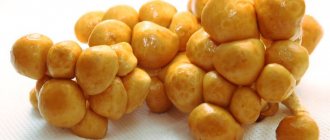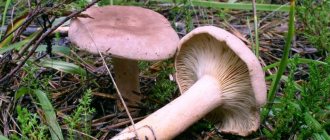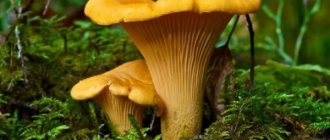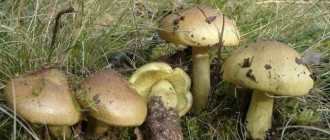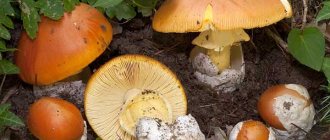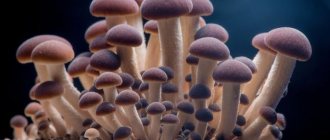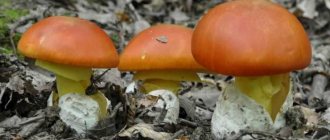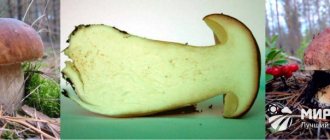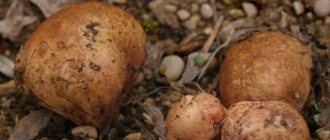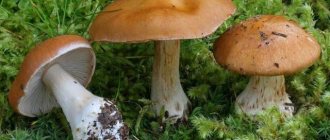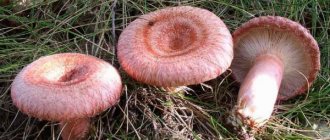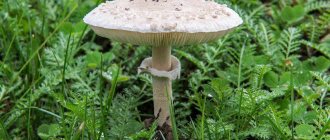Chestnut or oily collibia (Collybia butyracea)
HABITAT: mixed and coniferous forests, on the forest floor, on rotting wood, usually growing in groups.
SEASON: May - October.
In the middle and end of May, the first species of collibia appear. These include primarily chestnut or buttercollibia. These cute little mushrooms attract with their spectacular appearance, although they are small in size. Although they are edible, they are not collected due to their small size and the lowest, fourth category in terms of nutritional properties.
At this time, you can observe many singing birds in the forest, for example buntings, which climb onto the upper branches and sing, sing, sing.
The cap has a diameter of 3-8 cm, at first hemispherical, later convex with a round tubercle and then prostrate with a flat tubercle and raised or curved edges. A distinctive feature of the species is the chestnut-brown color of the cap with a flat tubercle of a darker brown color and light, cream or light brown edges.
The leg is 4-9 cm tall, thin, 2-8 mm thick, cylindrical, smooth, at first creamy, later pale brown. The base of the leg is thickened.
The pulp is watery, thin, soft, whitish or yellowish, at first odorless, later with a faint moldy odor.
The plates are cream or yellowish, emarginately adherent. Between the adherent plates there are short free plates.
Variability: The color of the cap varies depending on the maturity of the mushroom, the month and the humidity of the season. The color can be chestnut-brown, especially in early summer, red-brown with a brown tint, brown-brown with a dark middle, gray-brown with an olive tint, lilac-brown. During the dry season, the cap fades to light shades of yellow, cream and light brown.
Similar species. The chestnut colibia is similar in shape and size to the edible wood-loving colibia (Collybia dryophila), which differs in that it has a much lighter cap.
Edibility: edible, but require preliminary boiling in 2 waters to eliminate the mold smell.
Edible, category 4.
REPORT:
RESULTS
RESULTS the
RESULTS. RUSSIAN RESEARCH RESULTS. RESPONSIBILITY
RESULTS ºÐ¾Ð¼ в оÑеннем ÑоÑновом леÑÑ. Bay bolete, bay boletus, boletus badius mushroom, bay boletus ¾Ð¼ леÑÑ
RESULTS
RESULTS. Cep boletus. mushroom in forest Porcino, bolete, boletus.White mushroom on green background .Natural white mushroom growing in a forest
RESULTS
RESULTS
Mushroom places
The richest places in mushrooms in the Altai Territory in 2022 are the following:
- Barnaul, Burlinsky, Kasmalinsky and Kulundinsky forests;
- Upper Ob and Middle Ob forests;
- Volchikhinsky, Krutikhinsky and Pankrushikhinsky districts (there are especially many boletus mushrooms here);
- Talmensky and Zarinsky districts;
- Mamontovsky and Rubtsovsky districts - porcini mushrooms, milk mushrooms;
- Blagoveshchensky, Romanovsky and Biysky districts - white, various types of boletus;
- the villages of Pavlovsk and Zalesovo - honey mushrooms, boletus, moss mushrooms, milk mushrooms;
- Rebrikhinsky and Troitsky districts - chanterelles, honey mushrooms, boletus mushrooms;
- Novichikhinsky district - milk mushrooms, boletus, white ones.
The most important places where mushrooms grow in abundance and where you can safely go for a forest harvest are:
- Rebrikhinsky;
- Mamontovsky;
- Volchikhinsky;
- Rubtsovsky;
- Novichikhinsky;
- Blagoveshchensky;
- Trinity;
- Talmensky;
- Kamensky;
- Krutikhinsky;
- Biysk;
- Romanovsky;
- Pankrushikhinsky;
- Zarinsky.
The year turned out to be fruitful for chanterelles. Delicious mushrooms are collected in Kosikhinsky, Troitsky, Rebrikhinsky districts and other territories. For honey mushrooms, it is better to go to Ribbon Forest, Firsovo, Bobrovka or Sorochiy Log.
Butyracea, f. asema form (Collybia butyracea, f. asema)
HABITAT: mixed and coniferous forests, grow in groups.
SEASON: May - September.
The cap has a diameter of 2-5 cm, at first convex with a drooping edge, later convex-spread. A distinctive feature of the species is a cap with three zones: the central, darkest - brownish, the second concentric - cream, or cream-pink, the third concentric zone at the edges - brownish.
The leg is 3-7 cm tall, 3-8 mm thick, cylindrical, at first white, later light cream and gray-cream. Near the base of the leg, separate zones of a reddish-brown color appear over time.
The pulp is dense, fibrous, whitish, without much odor, the spore powder is light cream.
Medium-frequency plates, initially white, later cream-colored, notched.
Variability: The color of the central zone of the cap varies from brownish to brown, and the concentric zones range from cream to yellow-brown.
Similar species. This species is similar to Collybia dryophila, which also has concentric zones of cap color, but their central zone is reddish-brown and the next zone is yellowish-cream.
Inedible.
Biological description
- The cap is 2-12 cm in diameter, hygrophanic, convex when young, then broadly convex, flat and depressed, sometimes with a small tubercle in the center, smooth, oily in wet weather, brown or reddish-brown, then light brown surface. asema
form has a grey-brown cap. - The pulp is white, soft, watery, without much taste or smell.
- The hymenophore is lamellar, the plates are adherent to the stalk or almost free, often located, white, slightly pinking with age.
- The leg is 2-10 cm long and 0.4-1 cm thick, more or less even, usually hollow, rather hard, smooth.
- Spore powder is creamy, yellowish or pinkish in color. Spores are 6-8×3-3.5 microns, elliptical in shape, smooth.
Edible.
Edible mushrooms, berries, herbs
Collybia fusipes
The spindlefoot collibia can be found from the second ten days of July to the third ten days of September in deciduous forests (most often where there is oak or beech). Prefers to grow near oak (beech) stumps, tree roots, along fallen trunks, around stumps. It grows in fairly large groups, united in bunches. It is most widespread in the southern regions of our country.
The cap, 3-8 cm in diameter, is at first bell-shaped, later convex-lumpy with a smooth surface. The color is brownish-brownish or reddish-reddish-brownish with a darker center. In adult individuals, the surface of the cap is most often uneven with cracked edges, and the color becomes lighter. Red-brown spots may also appear on the surface.
The plates are sparse, mid-frequency, poorly adherent, grayish-white in color with red-brown spots.
The leg has a spindle-shaped shape, swollen just below the middle. 6-9 cm in length, 0.5-1.8 cm in diameter. The structure is longitudinally fibrous, wrinkled and furrowed. The swollen part is almost hollow, light at the top, red-brown at the bottom, and brown at the very base. Very often the leg is twisted or longitudinally twisted.
The pulp is white, thin-fleshed, elastic, somewhat harsh in the stem, with a subtle odor.
It is considered a mildly poisonous mushroom. However, in some reference books it is equated to edible or conditionally edible. Thus, the French writer-mycologist Gerard Houdou in his encyclopedia “Mushrooms” advises collecting the caps of young spindle-footed collibias and using them fresh or pickled.
Photos of Collybia fusipes
A video about the spindlefoot collibia, which allows you to better understand the structure of the fruiting body and imagine how the mushroom grows in the forest.
https://youtube.com/watch?v=wX23ZqglddE
An excerpt characterizing Collibia oilseed
- You love him? “Yes,” Natasha whispered. -What are you crying about? “I’m happy for you,” said Princess Marya, having completely forgiven Natasha’s joy for these tears. – It won’t be soon, someday. Think about what happiness it will be when I become his wife and you marry Nicolas. – Natasha, I asked you not to talk about this. We'll talk about you. They were silent. - But why go to St. Petersburg! - Natasha suddenly said, and she quickly answered herself: - No, no, this is how it should be... Yes, Marie? This is how it should be... Seven years have passed since the 12th year. The troubled historical sea of Europe has settled into its shores. It seemed quiet; but the mysterious forces that move humanity (mysterious because the laws determining their movement are unknown to us) continued to operate. Despite the fact that the surface of the historical sea seemed motionless, humanity moved as continuously as the movement of time. Various groups of human connections formed and disintegrated; the reasons for the formation and disintegration of states and the movements of peoples were prepared. The historical sea, not as before, was directed by gusts from one shore to another: it seethed in the depths. Historical figures, not as before, rushed in waves from one shore to another; now they seemed to be spinning in one place. Historical figures, who previously at the head of troops reflected the movement of the masses with orders of wars, campaigns, battles, now reflected the seething movement with political and diplomatic considerations, laws, treatises... Historians call this activity of historical figures reaction. Describing the activities of these historical figures, who, in their opinion, were the cause of what they call the reaction, historians strictly condemn them. All famous people of that time, from Alexander and Napoleon to m me Stael, Photius, Schelling, Fichte, Chateaubriand, etc., are subject to their strict judgment and are acquitted or condemned, depending on whether they contributed to progress or reaction.
Collybia chestnut. Chestnut money (Collybia butyracea)
Collybia chestnut. Chestnut money (Collybia butyracea) photo Grows in coniferous and deciduous forests. Fruiting bodies appear in July-September, often in large groups. The cap is 6-8 cm in diameter, fleshy, convex at first, later spread out, chestnut or brown, darker in the center, fading. The pulp is watery, soft, pale brown with a reddish tint.
The plates are initially adherent, later free, thin, white, with uneven jagged edges. Spore powder is white. The stem is 4-9 cm long, 1-1.5 cm thick, widened and thickened towards the base, dense, hard, the same color as the cap.
Chestnut collibia is edible, category 4. Used boiled, salted, pickled.
general characteristics
All representatives of the genus Kollibia have similar characteristics:
- Cap: thin-fleshy, in rare cases has well-developed flesh, small in size, does not exceed 2 cm in diameter, convex in shape at the initial stage of growth, subsequently flat-spread, in adult specimens a pit appears in the central part, in young mushrooms it has rolled edges, pale color in shades of white, brown and yellow.
- Hymenophore: formed by frequent plates, attached at the base to the mushroom stem or free; the color of the hymenophore plates can be pale cream or light brown.
- Leg: thin, covered with a powdery coating, the lower part of the leg is usually hairy, the shape of the leg is often smooth, cylindrical, in some cases swollen.
Some varieties of collibia form sclerotia.
Collibia confluens (money confluens, Gymnopus confluens) what mushrooms look like, where and how they grow
Money merging (kollibia merging): photo and description
| Name: | Money merging |
| Latin name: | Gymnopus confluens |
| View: | Inedible |
| Synonyms: | Collybia confluens, Collybia confluens |
| Characteristics: |
|
| Taxonomy: |
|
Mushroom pickers often encounter entire clearings of long-legged bell-shaped mushrooms on their way. Collibia confluentus often grows on stumps in groups of 2-9 or more specimens
Mushroom pickers without much experience often mistake them for honey mushrooms, but in order not to make a mistake when collecting, it is important to know the varietal characteristics and look at the photo
What does confluent collibia look like?
Collibia confluent, or money confluent, is an inedible species. So, in order not to harm your own body, you need to be able to recognize mushroom species by their external properties.
Description of the cap
When young, the mushroom has a hemispherical cap with a diameter of 20 mm. As the cap grows older, it increases in size and takes on the shape of a bell with a pronounced tubercle in the very center. The glossy surface is smooth and thin, through which you can easily see the lamellar bottom. The skin is painted light brown. The edges are very light and wavy. With age, the color lightens to a fawn or cream color.
On the inner side there are countless narrow plates of a whitish or yellowish color, adherent or partially adherent.
Like all representatives of the fungal kingdom, Collibia confluensum reproduces by long spores located in the spore powder.
Description of the leg
The longitudinally folded cylindrical leg can reach a height of 100 mm and a thickness of 5 mm. The pulp is hard and fibrous, covered in a white-yellow color, which changes to rusty-red or red-brown with age.
Let's eat the mushroom or not
Despite the fact that the pulp is dominated by a pleasant taste, the mushroom is considered inedible, since it exudes the fetid odor of rotten cabbage.
Where and how does it grow
This species can be found in large families in mixed deciduous forests, on rocky areas, in fallen leaves, on stumps and in dust. Fruiting begins in mid-July and lasts until the first frost.
Doubles and their differences
Collibia confluentus has edible, toxic and conditionally edible counterparts.
- Buttercollibia - an edible variety with a red-brown leg and a cap of the same color measuring up to 120 mm. The surface is smooth, but after rain it becomes covered with mucus. The species has hard flesh and grows in coniferous forests.
- Mycena oblique is an edible species that has a thin bell-shaped cap. Prefers to grow on stumps in an oak grove.
- Collibia spotted is a conditionally edible species. The fused white cap is covered with individual reddish spots. Grows in deciduous and coniferous loess.
- Collibia wrapata is an inedible variety with a brown-red cap. The surface is smooth, and during drought it acquires a golden color.
- The tuberous collibia is a dangerous species. The mushrooms are small in size and cream colored. If consumed, they may cause food poisoning.
Conclusion
Due to its hard pulp and unpleasant aroma, collibia confluent is considered an inedible species. Thus, in order to protect yourself, it is worth looking at the photo and getting acquainted with the varietal parameters. Qualified mushroom pickers recommend passing by an unfamiliar specimen, as confusion often occurs and toxic species enter the basket.
Collibia tuberous
Tuberous collibia - lat.Collybia tuberosa
This variety is otherwise called Tuberous collibia, Tuberous agaric, Tuberous microcollibia, Tuberous Gymnopus, Tuberous Gymnopus or Tuberous Gymnopus.
Description
Mushroom cap
The diameter of the tiny cap of Collibium tuberifera is about 2-15 mm: it resembles a tiny saucer. At a young age, mushroom caps look like hemispheres with folded edges. As the head grows older, it straightens and becomes flat, with smooth or wavy edges.
The smooth skin covering the cap of Microcollibia tuberosa is white, whitish or pale cream in color, with a darker, deeper middle. The edges of the hats always remain white and the radial stripes of the plate bottom are visible through them.
Gymnopus tuberiferous is filled with delicate thin white pulp.
The bottoms of the hats are dotted with many wide, different-sized fused plates of white or whitish-pink hue.
Collibia tuberosa reproduces by smooth, colorless ellipsoidal or teardrop-shaped spores that ripen in white spore powder.
Stipe
The thickness of the thin leg of the tuber worm is approximately 5-15 mm and rarely reaches 20 mm, the height varies between 10-50 mm. The leg is made in the form of a smooth cylinder, often smoothly bending, especially at the base. A white coating often forms at the top.
The legs are empty inside and consist of coarse fibers. Their surface is painted whitish, ocher or brownish. They grow on granular, smooth sclerotia formed from rotting lamellar fungi. It resembles a rounded or elongated tuber of yellowish or red-brown color - darker than the color of the fruiting body of Gymnopus tuberiferous.
Tuberous collibia – Collybia tuberosa
Places of growth
The fungus prefers old fruiting bodies of lamellar fungi growing on wood or fertile soil in mixed forests of northeastern regions and countries. The sclerotium described above is formed on them, the shape of which at the initial stage is often similar to an apple seed.
It forms on old, rotten or half-decomposed boletes, hidiums, russula, saffron milk caps, polypores and other representatives of the fungal kingdom. The main thing is that they have large dimensions and are meaty.
Microcollibia tuberosa bears fruit in the form of numerous colonies in summer, September and October.
The pulp of Collibium tuberous does not have a rich taste and aroma, and is not an edible mushroom, although it does not contain strong toxins. Therefore, if mushroom hunting takes place in clearings and other places favored by edible russula and saffron milk caps, you need to be especially careful not to pick up inedible mushrooms and eat them.
Mushrooms Collibia (Udemansiella) wide-lamellar: photo and description, how to cook
| Name: | Collibia broadleaf |
| Latin name: | Megacollybia platyphylla |
| Type: | Conditionally edible |
| Synonyms: | Megacollibia broadplate, Udemansiella broadplate, Money broadplate, Collybia platyphylla, Oudemansiella platyphylla |
| Characteristics: |
|
| Taxonomy: |
|
Collibia broadplate (Udemansiella) is a type of mushroom belonging to the Negniuchnikov family. It is also popularly known as wide-plate Money.
What does Collybia broadplate look like?
This is a lamellar mushroom with a thin stalk, reaching 15 cm in diameter. It has thin white pulp with a faint odor.
Description of the cap
Cap sizes can vary from 50 to 150 mm. In young individuals it is bell-shaped; As it grows, it gradually opens up and eventually bends upward. A tubercle remains in the middle of the cap. The cap is gray or gray-brown, darker in the tubercle area. Due to the radial structure of the fibers, in dry weather the cap may crack at the edges.
The plates are brittle, wide, adherent to the stem, and are not often located. In young specimens they are white, in adults they darken and acquire a gray-brown tint.
Description of the leg
The thickness of the leg ranges from 5 to 30 mm, and the height from 50 to 150 mm. A stem formed by longitudinal fibers, usually cylindrical in shape, somewhat tapering from the base to the cap. The color of the leg can vary from light gray to brown.
Is the mushroom edible or not?
In different sources you can find different information about the suitability of Collibia broadleaf for food. Experts classify it as conditionally edible. In addition, this type does not have a distinct taste. It may be of interest to mushroom pickers due to the fact that it can be collected already at the beginning of summer, long before other mushrooms appear.
How to cook Kollibia broadleaf
The wide-laminated collibia is pre-boiled for 15 minutes to get rid of the unpleasant woody taste, then it is pickled, salted or fried.
Where and how does it grow
Collibia is widespread in deciduous and mixed forests in the European part of Russia. It can be found in the Caucasus, the Far East, as well as in Western and Eastern Siberia.
The collection season for Collibia broadplate begins in late spring and ends in mid-autumn. Single individuals or their clusters can be found on rotten stumps or fallen trunks of deciduous trees, most often oak, alder and birch.
Doubles and their differences
An edible mushroom of the IV category, Plutaeus deer, which has a similar appearance, can be confused with Collibia broadplate. You can distinguish Pluteus deer by the following characteristics:
- its spores are pink;
- the plates are pinkish, located noticeably more often than those of Kollibia;
- the smell of the pulp is similar to the smell of radish;
- the plates do not reach the stem;
- there are no rhizoid strands.
Conclusion
Collibia broadleaf is a conditionally edible mushroom found throughout Russia. It is little known to amateur mushroom pickers, since it does not have much nutritional value, but it may be of interest due to the early start of the season, when there are no other mushrooms yet.
Wood-loving collibia - description of where it grows, toxicity of the mushroom
According to the variety of mushrooms, wood-loving collibia is classified as a member of the non-rot mushroom family. This type of mushroom is popularly called spring honey mushroom due to its external resemblance to honey mushrooms. However, often such confusion occurs due to mistake and inexperience of the mushroom pickers themselves. In fact, colibia is considered a parasitic fungus and has nothing in common with honey mushrooms.
According to the classification of edibility, the representative of the mushroom kingdom, collibium, is usually classified as a conditionally edible mushroom of the fourth category. After the collibium is in the mushroom picker's basket, it should be cooked. The mushroom must first be boiled and the resulting broth drained, only after that it can be used for food.
Characteristics of wood-loving collibia
Young colibia mushrooms have a cap that looks like a sphere. As the mushroom develops, its cap acquires an outstretched, flat shape with transparent edges. The diameter of the mushroom cap reaches approximately 2-6 cm. Young colibia fungi have some similarities with apples that fell on fallen leaves in the forest.
The core of the mushroom has brown, light yellow or sometimes white flesh. The color of the pulp directly depends on the conditions and environment in which the mushroom ripens. If you look through the thin and transparent edges of the cap, you can see plates that are weakly attached to the base of the mushroom. The older the mushroom ripens, the more it will become covered with reddish spots that appear on the inside of the fruit. The transparent and thin edges begin to tear.
The mushroom stem has a thin base, it is hollow inside and curls slightly along its length, becoming slightly thicker at the end. The structure of the mushroom stalk has a fibrous and cartilaginous surface. The cap and leg are the same color. The mushroom stalk can reach 2 or 6 cm in length.
Is the wood-loving collibia edible?
Collibia is an edible mushroom, so it can be used in culinary recipes. However, due to its low taste, it is not in particular demand among mushroom pickers. In addition, if a person has disorders associated with digestive problems, then this mushroom should not be used as food. Collibium can cause intestinal and stomach ailments and pain.
Collibia is also not very popular among chefs, since there is very little soft core and pulp inside the mushroom for cooking. In addition, the mushroom does not have a strong aroma or taste. The aroma of collibium can even, on the contrary, give dishes an unpleasant odor mixed with mold and rot.
Collibia growing environment
The habitat of the fungus is considered to be the forest, which is why collibia is called forest-loving. You won't find it in fields or gardens. Collibia can be found in deciduous and coniferous forests. This type of mushroom family grows most often in the European part of Russia.
The first mushrooms germinate in May and produce entries until the end of autumn. You can find colibia among the foliage, in a damp lowland, in a rotting fallen tree or on a stump. Thanks to such places, the fungus survives and receives the substances and water it needs. The fungus can also grow on the surface of a tree trunk.
Doubles in the kingdom of mushrooms
The wood-loving collibia also has close relatives. Collibia oleracea is considered such a relative of the mushroom; it also belongs to the conditionally edible varieties of mushrooms. The mushroom is brown or red-brown in color. Also, wood-loving collibia can often be confused with some other species of the collibia family, which, moreover, can be very poisonous and life-threatening. However, poisonous varieties are quite rare. Only mushroom pickers with extensive experience can find the difference between a poisonous and an edible mushroom.
Satanic mushroom (Boletus satanas)
A tubular mushroom belonging to the boletus genus. In our country it grows in the Caucasus, in the southern regions of the European part and in the south of the Primorsky Territory, where it settles in forests. Forms a symbiosis with trees such as linden, oak, beech, chestnut and others. It is similar to the edible oak mushroom; it is easy for an inexperienced mushroom picker to make a mistake.
Satanic mushroom
A large mushroom with a cushion-shaped cap up to 20 cm in diameter, light gray or ocher-white in color. A sponge consisting of tubes with red stomata is visible on the underside. The leg is 10 cm long, thick (up to 6 cm in diameter), yellowish, and has a red mesh at the bottom. Old mushrooms emit a very unpleasant odor.
In some habitats it is considered conditionally poisonous, and with appropriate processing it is eaten. However, there is no reliable data on the safety of this mushroom, so you should not conduct experiments on yourself and your loved ones.
When picking mushrooms, you need to be careful and careful
When picking mushrooms, you need to be careful and careful. Never take a mushroom if you doubt its safety. The following video describes the ten most poisonous mushrooms found in the CIS countries.
https://ogorod-bez-hlopot.ru/opisanie-korichnevyx-gribov.html
https://vk.com/topic-48875560_27562447
https://7dach.ru/LenaMedvednikova/top-10-yadovityh-gribov-kotorye-tochno-ne-stoit-klast-v-korzinu-148897.html
Blue mushrooms. Time for the Blues
What to look for?
Purple row (Lepista nuda) is the most recognizable, widespread and popular representative of this genus of “perfume” mushrooms.
In the south, in terms of recognition, it can be rivaled by the “bluefoot” or lilac-legged row (Lepista personata, nee L.saeva) - a similar, but larger mushroom with a dirty gray cap and a surprisingly bright, lilac-violet leg. (Well, why does nature need this? Is it just for beauty...) Our “bluefoots,” however, don’t grow much - in captivity, I only met them on the territory of the children’s cardiology center, and there it’s somehow inconvenient to tinker with mushrooms. Purple row as it is (photo by Zeff)
The purple rower, simply a “titmouse,” looks very characteristic, but its color is not easy to describe. For one simple reason: the mushroom is hygrophanic. That is, the cap actively absorbs moisture and changes color depending on the humidity. So, for example, the wet center of the cap can be brown-purple, and the drying edges can be gray-violet. Having filled with moisture, the mushroom darkens; when it dries it becomes lighter. In general, in one day, a purple row can reflect the full color gamut from dark purple to light purple. But the plates do not change color. They are blue, like the evening sky over the Kalahari Desert.
Where to look?
Strictly speaking, the titmouse is not tied to any type of tree and can grow anywhere. I first found it on my compost pile. However, its requirements for the substrate are quite strict. Purple row is a surface-occurring mushroom; it processes the forest floor, piercing fallen pine needles and leaves with many fine threads and therefore does not like being stirred up or trampled on. Theoretically, you can find it literally anywhere, but in practice you should only look where there is less traffic. I collect it in an old spruce forest - there, on a lush and thick litter, it leads rich round dances.
And this is the southern “bluefoot” (photo by Sergei Prokofiev)
In places trampled by mushroom pickers, the titmouse and its close relatives are huddled in unpopular thickets, no matter whether deciduous or coniferous; the only important thing is that there is less trampling there
What to confuse with?
The easiest way to confuse the purple rower is with its close relatives; It’s not scary, many mushroom pickers don’t even try to differentiate. In the same places and at the same time, weed row (Lepista sordida) grows; it is exactly the same, but twice as small. The purple-legged rower, the blue-legged blue-legged (Lepista personata) is larger, it has a nondescript cap and a bright blue leg; It doesn't happen very often here. The blue-gray rower (Lepista glaucocana) resembles a cross between a titmouse and a smoky talker. It is worth distinguishing between these mushrooms only for scientific purposes.
Purple web spider. Is it really similar? (photo by I. Lebedinsky)
An inexperienced mushroom picker may confuse the purple row with some violet-colored spider web - for example, the white-violet spider web (Cortinarius alboviolaceus) or with the purple spider web itself (Cortinaruis violaceus). Cobwebs are distinguished by a pronounced cobwebby (! - sic!!!) blanket that protects the plates of young mushrooms, and then remains in the form of bracelets or streaks on the stem. The plates of a mature spider web acquire a rusty-brown color or at least a shade; This never happens with rows. Taking a blue spider web instead of a titmouse is not dangerous, they are not poisonous, and the purple one is completely edible. But they should be handled differently in the kitchen, so it’s best not to let your guard down.
How to cook?
The blue row is a rather valuable and certainly edible mushroom; He is also respected in Europe, which should indicate his complete harmlessness. At the same time, it is sometimes indicated that titmouse can have a depressing effect on people with sensitive digestion, and the authors recommend boiling it for 15-20 minutes. I don't practice this; True, I’m not in the risk zone either.
Overripe row is gray-blue. It’s too late to cook something like this (photo by I. Lebedinsky)
In my opinion, this mushroom reveals itself best in a marinade. In a light, lightest marinade; cook for five minutes, add vinegar to the brine - purely homeopathic. Cloves (a little!) and coriander will help to emphasize the rather unusual taste of titmouse. Unlike the smoky talker, the blue row does not create an “explosion in a perfume factory” when cooked; its aromatic component does not go beyond the bounds of decency.
What is the value of the “money” mushroom Kollibia chestnut?
Collibia oleracea is a mushroom of the non-rotting family. It grows in temperate latitudes in Europe and North America. Currently, about 70 of its varieties are known; in Russia there are more than 20 species.
Description
Lat. Rhodocollybia butyracea, Collybia butyracea. Other names are Rhodocollibia oily, Kollibia oily, Kollibia chestnut, Money oil.
This is a genus of capped, late-ripening, conditionally edible, collibioid mushrooms of the Ryadovkov family, which are often called “money” for their external resemblance to small coins.
hat
The young mushroom has a hemispherical cap. Over time, it becomes more convex, and later takes on a prostrate, slightly depressed appearance with upward-curved edges. Its diameter is 2–12 centimeters. Some specimens have a small tubercle in the center.
The cap of the Collibia oilseed is hygrophanous, that is, it is capable of changing its appearance depending not only on age, but also on the level of humidity in the growing area. In rainy weather, its surface becomes oily.
The color of the cap can be light brown, reddish, burgundy, chestnut, or brown. The edges are painted in lighter colors.
Hymenophore
The lower part of the cap, or hymenophore, consists of a large number of frequently located plates. They are located freely or can be tightly attached to the leg. Between the large plates there are shortened intermediate ones.
A characteristic feature of collibia is the white color of the hymenophore. During the ripening process, it acquires a pink tint, and with age the plates become darker.
The spores are smooth and have a slightly elongated elliptical shape. Their powder is white, pale yellow or pinkish in color.
Pulp
Collibia is a thin-fleshed mushroom. The pulp is watery and white or light brown in color. Under the skin it is a rich brown color.
Leg
The leg is smooth, cartilaginous, rigid, hollow inside. Its length ranges from 2 to 10 cm, its girth can reach 1 cm. In the upper part, under the cap, it is slightly flattened, and in the lower part it has a slight thickening, covered with a white felt coating.
Time and place of fruiting of oil money
The mushroom is quite rare. At the same time, it is well camouflaged near the bases of trees and is not always noticeable to mushroom pickers.
Rhodocollybia butyracea is a saprotroph that grows in coniferous and deciduous forests on dried wood, grass, mosses or leaf litter. Most often it can be found in a pine forest.
It grows from the beginning of summer until the first snow, when there are no other relatives. When harvesting, the fruiting body is cut off at the root, and this place is covered with earth or leaves.
False doubles
The main difference between the money and related species, including inedible ones, is the oily cap. The following varieties may be of interest to lovers of “silent hunting”:
- Collibia spotted. It belongs to the conditionally edible mushrooms and close relatives of the butter mushroom. It has a conical or hemispherical cap with the edges turned down. Its surface is white with brown-rusty spots, which serve as a distinctive feature. The pulp is elastic and very dense. The leg is slightly curved, painted white with small brown spots on the surface. It requires moist and acidic soil to grow. Found in very large families.
What is the difference between different types of colibia can be seen in the photo
Taste qualities of Collibia oily
Buttercollibia has a sawdust taste, so it is rarely eaten, although it is classified as a conditionally edible mushroom. To get rid of the unpleasant taste, it is first boiled for 10–15 minutes. Only the caps are used for cooking.
Cooking recipes
After collection, collibia should be properly processed.
- To do this, pour it into a large container and fill it with cold, lightly salted water for 10 minutes. This procedure will help you quickly get rid of dirt, soil, stuck leaves and insects.
- Then the mushrooms are washed and the caps are separated from the stems, since money butter stems are hard and are not used for cooking.
- Clean fruiting bodies are placed in a large saucepan, filled with cold water and brought to a boil over high heat.
- Reducing the flame, cook for another 15 minutes, then drain and rinse with running water.
Cooked mushroom preparation can be used with onions, carrots, garlic, pepper and sour cream. Collibium goes well with stewed potatoes, chicken and meat. It can also be pickled and salted.
RESPONSIBILITY:
Suillus luteus
Grihroom suillus luteus in dry pine needles close seup. RESULTS . Rhodocollybia butyracea. rhodocollybia butyracea ROOM RESULTS. RESULTS .
rhodocollybia butyracea RESULTS. RESULTS. RESULTS .
suillus luteus suillus luteus леÑÑ. RESULTS. RESULTS .
Suillus luteus suilus luteus RESULTS .
RESULTS ²Ð¾Ð¼ леÑÑ ÐºÑÑпнÑм планом. ROOM, ROOM на ÑезкоÑÑи .
Suillus luteus Suillus luteus Suillus luteus Ð»ÐµÑ Ð¿Ð¾Ð´ ÑоÑной. Suillus luteus luteus. RESULTS.
RESULTS »ÐµÑ. RESULTS. RESULTS .
Is the yellow mushroom edible or not? Gall mushroom (gorchak)
The gall fungus (gorchak), which is quite common in central Russia, also has the name false porcini mushroom.
There are several scientific theories about the origin of its bitterness, which cannot be destroyed by any culinary processing procedures.
The closest to the truth is the opinion that the pulp of this mushroom contains toxic substances that destroy liver cells.
In this regard, symptoms of poisoning may appear several weeks or months after eating it.
Poisoning, in fact, is quite rare due to the fact that when exposed to high temperatures during processing, the bitterness increases many times over. It is hardly possible to call such a dish edible. Most often, poisoning occurs when using false porcini mushroom for pickling and pickling.
When canned, the bitterness can be masked by various seasonings and vinegar.
Edible counterparts are the true porcini mushroom, boletus and boletus. A distinctive feature of the gall fungus is the color of the spongy substance on the back of the cap.
Unlike edible specimens, the false porcini mushroom has a pink tint. When cut, the leg quickly darkens and turns brown. The mesh that covers the fiber of the leg also has a brown tint.
Description of the gall fungus
You can find false boletus in any region of the Russian Federation.
It grows actively from late June to mid-October, depending on weather conditions. With early frosts, the growing season may end at the end of September. It grows both in groups of 5-15 individuals and singly on the outskirts of coniferous forests with sparse planting of trees. For growth it prefers light loamy soils and sandstones, abundantly fertilized with fallen pine needles.
According to the description, the gall mushroom resembles a porcini mushroom - it is a massive, strong stalk that is filled with fibrous pulp. The diameter of an adult individual can reach 7 cm. The outer layer is fibrous, covered with a dense mesh of brown or brown color.
Its cap is a spongy formation with a thin layer at the top of a dense porous substance in the form of pulp. A spongy substance of a pinkish hue, very bitter in taste.
If even a small amount gets on the tongue, it causes a strong burning sensation. The outer surface of the cap is covered with a dense film, which during growth can change its color from pale brown to rich ocher.
As they grow older, the hemispherical shape expands and becomes saucer-like, the inside of which resembles a pillow.
A distinctive feature is that this mushroom is never damaged by insects. Due to this, it looks very attractive. But you shouldn't add it to your basket.
If even a small piece of a false porcini mushroom gets into the mycelium, the taste of the dish will be irrevocably spoiled.
Be sure to look below in our photo gallery to see what the gall fungus bitterling looks like in the photo.
How does poisoning manifest itself?
As mentioned above, some biologists classify the mustard mushroom as inedible, but not poisonous. Scientists agree that eating this forest beauty is impossible only because of its unpleasant taste.
Foreign colleagues refute this theory. The pulp of the false porcini mushroom releases toxic substances that are quickly absorbed into the human blood upon any contact, even tactile contact. These substances penetrate the liver cells, where they exert their destructive effects.
On the first day after the “tongue test” while collecting this mushroom, a person may feel slight dizziness and weakness. Subsequently, all symptoms disappear. The first signs appear after a few weeks.
Problems begin with the secretion of bile. The functioning of the liver is impaired. At high concentrations of toxins, liver cirrhosis may develop.
Thus, you yourself can make the correct conclusion about whether the gall false porcini mushroom can be eaten and whether it is edible for humans. One has only to think that even forest animals, insects and worms do not try to feast on the attractive pulp of this representative of the mushroom kingdom.
